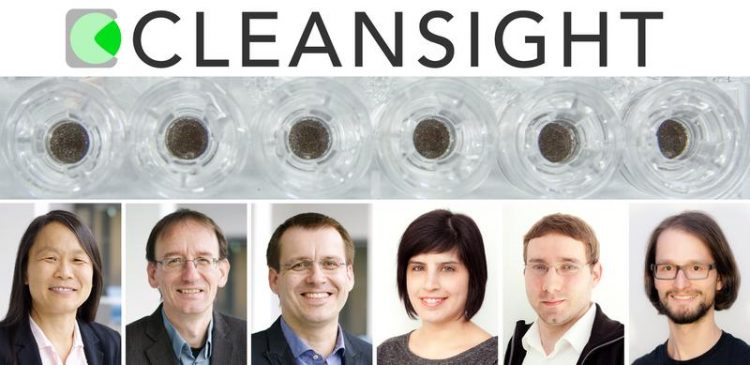CRTD receives 1.56 Mill. Euro BMBF-funding for retinal disease research

Retinal pigment epithelial cell culture & Cleansight team (left to right): Prof. Dr. Elly Tanaka, Prof. Dr. Marius Ader, Dr. Mike Karl, Dr. Seba Almedawar, Dr. Sven Schreiter & Dr. Dominic Eberle © CRTD, Dominic Eberle
With more than 150 million affected people, retinal degenerative diseases are one of the most frequent causes of visual impairment worldwide. Examples include genetically inherited Retinitis Pigmentosa (RP), and age-related macular degeneration (AMD). The prevalence of AMD is expected to reach epidemic proportions due to an increasingly aging population. There are currently no effective therapies to prevent or cure these diseases.
Retinal diseases are associated with build-up of waste products. Vision loss may occur, for example, when the retinal pigment epithelial cells (RPE), which underlie the neural retina, are impaired in taking up and recycling natural waste products of the retina.
This process, known as phagocytosis, is essential for visual function and survival of our light sensitive retinal neurons, called photoreceptors. Abnormal RPE cell function can lead to retinal degeneration, visual impairment and even loss of sight. Therapeutic compounds modulating RPE functions might prevent vision loss.
”The aim of CLEANSIGHT is to validate a RPE-based screening platform, which we have developed since 2013, to search for classes of compounds that are suitable candidates for the development of novel therapeutics, and bring it to industry standards. RPE cells used in this platform are derived from human stem cells by a patented and very efficient protocol, which made the platform development possible”, explains the research team consisting of Dr. Seba Almedawar (project leader), Dr. Sven Schreiter and Dr. Dominic Eberle, supported by Prof. Elly Tanaka, Prof. Marius Ader and Dr. Mike Karl. A procedure patented by Prof. Tanaka enables the production of large quantities of human RPE cells at uniformly high quality in the laboratory. This constitutes a major advance for the development of a screening platform for new therapeutic substances.
The awarded research grant is part of the new Hightech-Strategy „Innovationen für Deutschland“ of the German Federal Government. The rapid transfer of innovative ideas for products and services aims to strengthen Germany’s leading position as the largest national economy and exporter in Europe.
The Grant Office, CMCB (a service unit that supports CRTD, BIOTEC and B CUBE in the acquisition of third-party funds) and the Technology Transfer Office have both closely coordinated the CLEANSIGHT grant application and continue to offer their support to the project team.
Further information on CLEANSIGHT (Dresdner Transferbrief, Issue 2.16)
http://www.qucosa.de/fileadmin/data/qucosa/documents/20367/transferbrief_ausgabe… (pages 10-11)
Press Contact
Franziska Clauß
Press Officer
Phone: +49 351 458 82065, e-Mail: franziska.clauss@crt-dresden.de
Founded in 2006, the DFG Research Center for Regenerative Therapies Dresden (CRTD), Cluster of Excellence at the TU Dresden has passed the second phase of the Excellence Initiative which aims at promoting top-level research and improving the quality of German universities and research institutions. The goal of the CRTD is to explore the body's self-healing potential and to develop completely new, regenerative therapies for hitherto incurable diseases. The key areas of research include haematology and immunology, diabetes, neurodegenerative diseases and bone regeneration. At the moment, eight professors and ten group leaders are working at the CRTD – integrated into an interdisciplinary network of 87 members at seven different institutions within Dresden. In addition, 21 partners from industry are supporting the network. The synergies in the network allow for a fast translation of results from basic research to clinical applications.
Media Contact
All latest news from the category: Awards Funding
Newest articles

A ‘language’ for ML models to predict nanopore properties
A large number of 2D materials like graphene can have nanopores – small holes formed by missing atoms through which foreign substances can pass. The properties of these nanopores dictate many…

Clinically validated, wearable ultrasound patch
… for continuous blood pressure monitoring. A team of researchers at the University of California San Diego has developed a new and improved wearable ultrasound patch for continuous and noninvasive…

A new puzzle piece for string theory research
Dr. Ksenia Fedosova from the Cluster of Excellence Mathematics Münster, along with an international research team, has proven a conjecture in string theory that physicists had proposed regarding certain equations….



